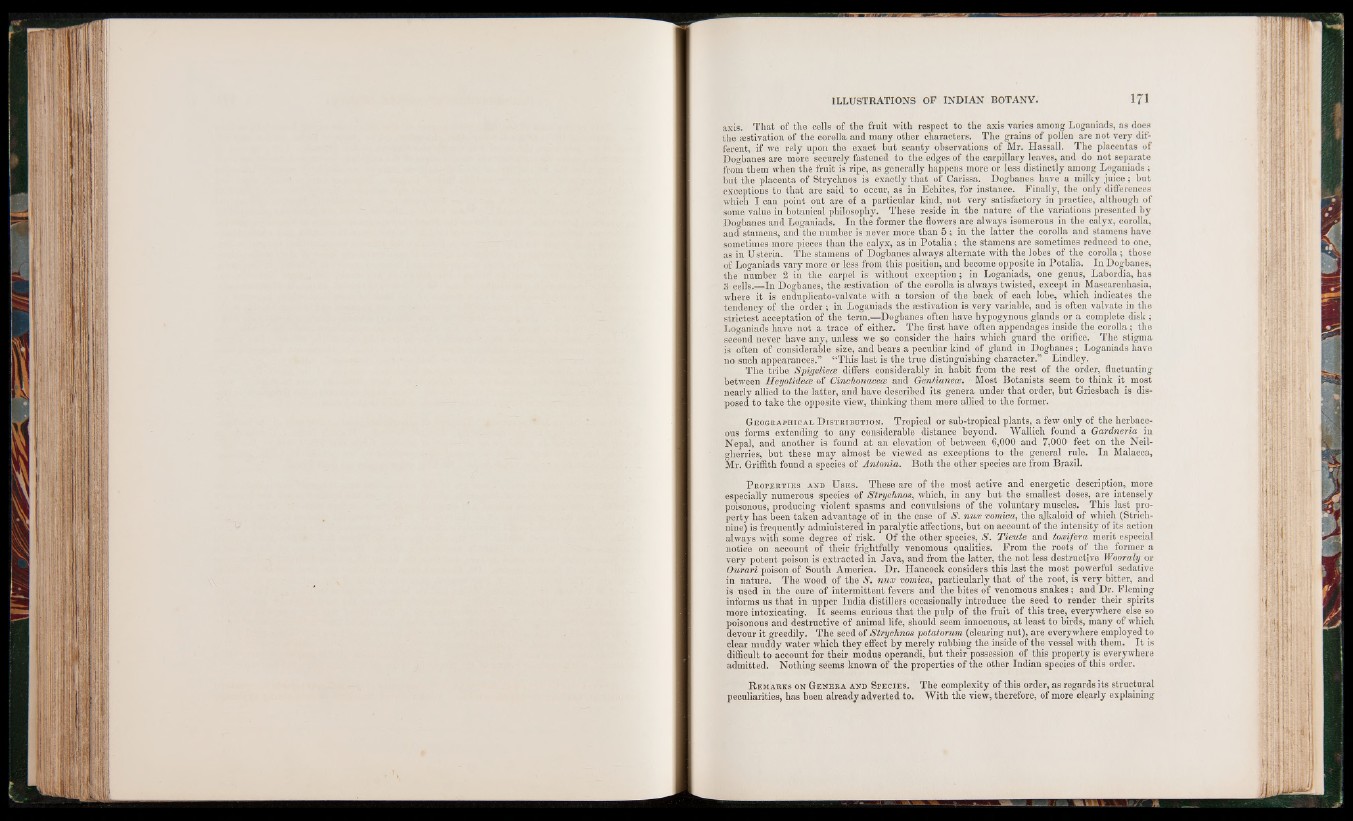
axis. That of the cells of the fruit with respect to the axis varies among Loganiads, as does
the aestivation of the corolla and many other characters. The grains of pollen are not very different,
if we rely upon the exact but scanty observations of Mr. Hassali. The placentas of
Dogbanes are more securely fastened to the edges of the carpillary leaves, and do not separate
from them when the fruit is ripe, as generally happens more or less distinctly among Loganiads;
but the placenta of Strychnos is exactly that of Carissa. Dogbanes have a milky juice; but
exceptions to that are said to occur, as in Echites, for instance. Finally, the only differences
which I can point out are of a particular kind, not very satisfactory in practice, although of
some value in botanical philosophy. These reside in the nature of the variations presented by
Dogbanes and Loganiads. In the former the flowers are always isomerous in the calyx, corolla,
and stamens, and the number is never more than 5 ; in the latter the corolla and stamens have
sometimes more pieces than the calyx, as in Potalia; the stamens are sometimes reduced to one,
as in Usteria. The stamens of Dogbanes always alternate with the lobes of the corolla; those
of Loganiads vary more or less from this position, and become opposite in Potalia. In Dogbanes,
the number 2 in the carpel is without exception; in Loganiads, one genus, Labordia, has
S cells.—In Dogbanes, the aestivation of the corolla is always twisted, except in Mascarenhasia,
where it is enduplicato-valvate with, a torsion of the back of each lobe, which indicates the
tendency of the order; in Loganiads the aestivation is very variable, and is often valvate in the
strictest acceptation of the term.—Dogbanes often have hypogynous glands or a complete disk ;
Loganiads have not a trace of either. The first have often appendages inside the corolla; the
second never have any, unless we so consider the hairs which guard the orifice. The stigma
is often of considerable size, and bears a peculiar kind of gland in Dogbanes; Loganiads have
no such appearances.” “This last is the true distinguishing character.” Lindley.
The tribe Spigeliece differs considerably in habit from the rest of the order, fluctuating
between Heyotidece of Cinchonacece and Gentianecs. Most Botanists seem to think it most
nearly allied to the latter, and have described its genera under that order, but Griesbach is disposed
to take the opposite view, thinking them more allied to the former.
Geographical D istribution. Tropical or sub-tropical plants, a few only of the herbaceous
forms extending to any considerable distance beyond. Wallich found a Gardneria in
Nepal, and another is found at an elevation of between 6,000 and 7,000 feet on the Neil-
gherries, but these may almost be viewed as exceptions to the general rule. In Malacca,
Mr. Griffith found a species of Antonia. Both the other species are from Brazil.
P roperties and U ses. These are of the most active and energetic description, more
especially numerous species of Strychnos, which, in any but the smallest doses, are intensely
poisonous, producing violent spasms and convulsions of the voluntary muscles. This last property
has been taken advantage of in the case of S. nuso vomica, the alkaloid of which (Strich-
nine) is frequently administered in paralytic affections, but on account of the intensity of its action
always with some degree of risk. Of the other species, S . Tieute and tomferd merit especial
notice on account of their frightfully venomous qualities. From the roots of the former a
very potent poison is extracted in Java, and from the latter, the not less destructive Wooraly or
Ourari poison of South America. Dr. Hancock considers this last the most powerful sedative
in nature. The wood of the S. nuso vomica, particularly that of the root, is very bitter, and
is used in the cure of intermittent fevers and the bites of venomous snakes; and Dr. Fleming
informs us that in upper India distillers occasionally introduce the seed to render their spirits
more intoxicating. I t seems curious that the pulp of the fruit of this tree, everywhere else so
poisonous and destructive of animal life, should seem innocuous, at least to birds, many of which
devour it greedily. The seed of Strychnos potatorum (clearing nut), are everywhere employed to
clear muddy water which they effect by merely rubbing the inside of the vessel with them. It is
difficult to account for their modus operandi, but their possession of this property is everywhere
admitted. Nothing seems known of the properties of the other Indian species of this order.
R emarks on Genera and Species. The complexity of this order, as regards its structural
peculiarities, has been already adverted to. With the view, therefore, of more clearly explaining